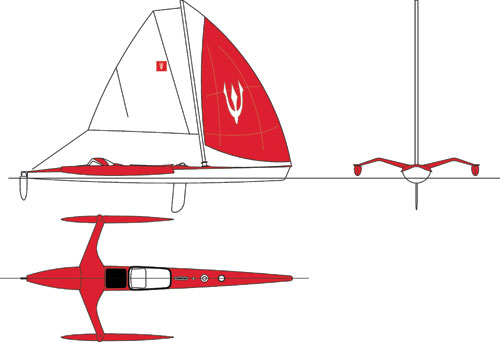Triak
Trimaran
Regular readers of my reviews know I like small boats. I think it's much easier to learn the fine points of sailing if you start in a small boat and preferably an unballasted dinghy. You learn quickly, as not learning means going swimming. My first solo sailing experience was in an awful little rented boat, the 8-foot Sea Scouter dinghy. It weighed about 250 pounds and the single sail was held onto the mast by shower curtain rings. I sat on the seat, bobbed around and wondered why the other boats on the lake seemed to just glide by me. If my own experience was not enough to convince me to learn to sail, watching the other boats effortlessly slide by was.
If you enjoy sailing and you also enjoy kayaking you should look at the latest update of the Triak trimaran. The problem with most sailing kayaks and canoes is that they lack stability. This Triak addresses that problem. The updates to the original design have been done by Morelli and Melvin and the firm certainly has as much experience in designing high-performance multihulls as anyone in the world.
The changes over the original model include a new main hull design with a near-plumb bow and more volume forward to help the tri carry the loads of the spinnaker. The amas now have wave-piercing bows and twice as much volume as the previous ama design. The rudder area has been doubled and a new daggerboard has more draft. Clearly the Triak has been optimized for sailing.
The Triak is 18 feet, 2 inches LOA with a max beam of 10 feet, 1 inch. The all-up boat weight is 65 pounds, and that's pretty light for an 18-foot trimaran. Steering is by foot pedals. The promo material says the boat will see "double-digit speed reaching and running in 10 to 15 knots of breeze in flat water." There is enough volume in the main hull to carry up to 250 pounds of gear in a dry storage compartment. That's a lot of camping gear. The daggerboard can be lowered and raised easily from the cockpit.
The rig features a fiberglass mast similar to that of a windsurfer. The 32-square-foot main is furled by a drum located right above the deck. There are bearings at the deck and at the mast base for low friction. A short "wand" keeps the head of the spinnaker forward and out of the way of the mast as the mast swivels. The snuffer for the 40-square-foot spinnaker fits in the bow of the main hull and all sail controls lead conveniently forward of the cockpit. A spinnaker retrieval line makes dousing the chute easy.
To carry the Triak on top of your car the amas connect to a removable wing that attaches to the main hull with four hand bolts, so no tools are needed. One hand bolt is all that is need to attach each ama to the wing. You can easily carry two Triaks on the car roof with standard kayak racks.
There are lots of ways to enjoy sailing. If the idea of some long-distance kayaking appeals to you then the thought of doing a lot of it while not having to paddle should be very attractive. I have a nice carbon fiber kayak. I enjoy it but the constant paddling gets old. The thought of unrolling the main, putting up the chute and sitting back while rolling off the miles makes a lot of sense.
LOA 18'2"; Beam 1'9" (hull), 10'1" (overall); Draft 2'9"; Weight 65 lbs.; Sail area 79 sq. ft.; SA/D 78.19; D/L 4.84; L/B 10.38 (hull), 1.8 (overall)
Triak Sports, P.O. Box 921, Solana Beach, CA 92075, (866) 858-7425 www.triaksports.com.
OBE: $5,999
Our Best Estimate of the sailaway price

Comments